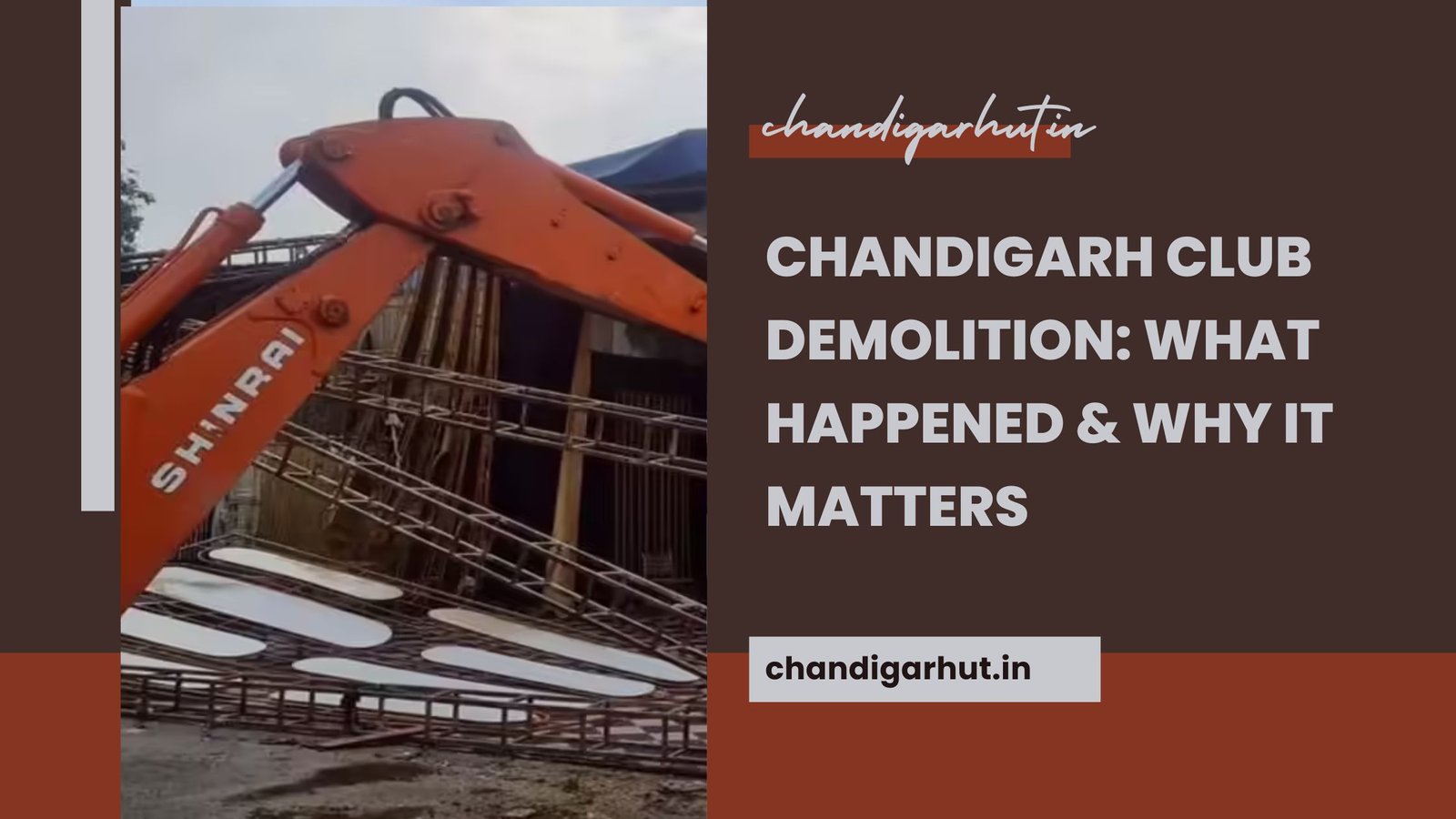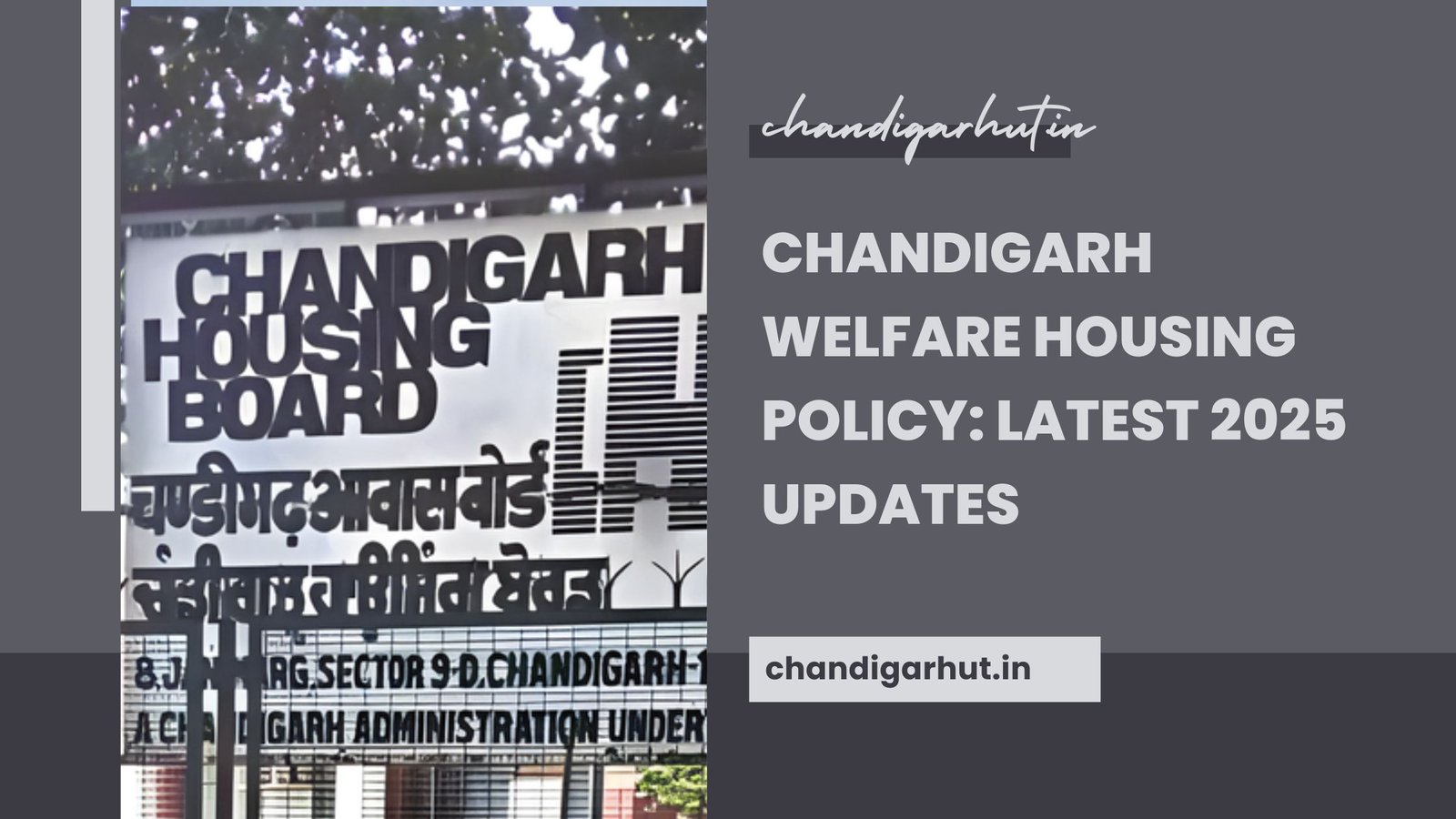The Chandigarh Club demolition on November 25, 2025, shocked club members, residents, heritage lovers, and urban planners across the city. Just before sunrise, enforcement teams moved in and dismantled 32 unauthorised structures — from a large commercial kitchen to banquet-style halls, tin sheds, toilets, and makeshift extensions reportedly erected after sub-leasing by a private caterer.
This sudden, large-scale Chandigarh Club demolition raised deep questions about governance, planning, legality, and the future of public land management in the city. What really happened? Why did it happen so fast? And what does it mean for Chandigarh moving forward?
This detailed guide breaks down the entire incident with clarity, expert insight, and E-E-A-T-backed explanations.
Executive Summary — Quick Read
- 32 illegal structures were removed during the Chandigarh Club demolition.
- The action happened after a court refused to stay demolition requested by the caterer.
- Structures included a commercial kitchen, banquet hall, tin sheds, toilets, and temporary extensions.
- Authorities stated that everything removed was unauthorised and constructed after a sub-lease.
- The Chandigarh Club demolition involved multi-department teams for safety and legal compliance.
- The event will shift how Chandigarh handles lease compliance, urban planning, and commercialization of public land.
What Is the Chandigarh Club Demolition? A Timeline & Key Facts
The Chandigarh Club demolition unfolded with precision, speed, and strong administrative coordination.
Where It Started
- Date: November 25, 2025
- Time: Around 6:00 AM
- Location: Chandigarh Club, Sector 1
- Action: Demolition of approx. 32 unauthorised structures
What Triggered the Enforcement?
The Estate Office had issued demolition orders after discovering:
- Illegal constructions
- Commercial activity beyond permissible club use
- Unauthorized sub-leasing
The Chandigarh Club demolition was not sudden — it followed multiple notices and inspections.
Why Action Proceeded Quickly
A last-minute petition by the caterer requesting a stay was not entertained in court, clearing the legal path for immediate enforcement.
Once the legal barrier was removed, the administration acted swiftly, leading to the final Chandigarh Club demolition drive.
Who Was Involved in the Chandigarh Club Demolition?
Chandigarh Estate Office & UT Administration
As the primary authority, the Estate Office:
- Enforces lease terms
- Monitors government land
- Ensures compliance with building bylaws
Its supervision ensured that the Chandigarh Club demolition targeted only structures listed in official orders.
M/s Commando Caterers Pvt Ltd
The caterer allegedly erected many temporary but commercially functional units:
- A large commercial kitchen
- Banquet-style spaces
- Tin sheds
- Service corridors and toilets
Reports suggest these structures emerged after a sub-lease, which is strictly prohibited under the club’s land lease terms. This made the caterer central to the Chandigarh Club demolition narrative.
The Judiciary
The caterer approached the court for relief.
But the court declined to stay the demolition, enabling the administration to move forward.
Multi-Department Enforcement Teams
The Chandigarh Club demolition involved:
- Police
- Engineering wing
- Fire department
- Health department
- Civil defence
This ensured:
- Law & order
- Structural safety
- Public protection
Why Did the Chandigarh Club Demolition Happen? Legal & Planning Context
Lease Conditions & Bylaws
Chandigarh Club sits on prime government land with strict conditions:
- No construction without approval
- No commercial activity beyond club operations
- No sub-leasing of any part of the property
Authorities found that the demolished structures violated all three.
This became a major justification for the Chandigarh Club demolition.
Notices Issued Before Demolition
Before carrying out the action:
- Multiple notices were issued
- Site inspections were conducted
- Illegal constructions were documented
Once the court refused to step in, the Chandigarh Club demolition proceeded as per rules.
Wider Crackdown on Illegal Constructions
The city has intensified actions against:
- Unauthorized cafés
- Street-side restaurants
- Encroachments
- Illegal extensions on public land
The Chandigarh Club demolition fits into this broader planning push.
What Exactly Was Removed in the Chandigarh Club Demolition?
The scale of the demolition was larger than initial estimates.
Approx. Area Affected:
Around 70,000 sq ft (1.6 acres)
Structures Removed
Major Commercial Structures:
- Large commercial kitchen
- Banquet hall-style setup
- Commercial activity zones
Secondary Structures:
- Tin sheds
- Temporary toilets
- Storage units
- Service passages
- Extra extensions
All removed areas were reportedly constructed without approval, which made them part of the Chandigarh Club demolition drive.
How Was the Chandigarh Club Demolition Carried Out?
Planning & Manpower
- Early morning execution
- Heavy machines (JCBs, excavators)
- Trucks for debris removal
Multi-Level Coordination
The Chandigarh Club demolition required seamless coordination:
- Police: Crowd control
- Engineers: Controlled dismantling
- Fire Services: Emergency readiness
- Medical Staff: On-site precaution
- Civil Defence: Ground support
Safety & Legal Compliance
Before the demolition:
- Water and electricity lines were disconnected
- The nodal officer cross-checked the demolition order
The approach followed Chandigarh’s strict operational protocols.
Reactions After the Chandigarh Club Demolition
Club Members & Management
Chandigarh Club, established in 1957, holds cultural and emotional significance.
Members expressed:
- Relief: Illegal structures removed
- Concern: Loss of services
- Worry: Operational uncertainty
- Questions: Transparency and governance
The Caterer’s Position
- Called the action abrupt
- Argued ongoing commercial rights
- May pursue future legal remedies
Public Reaction
City residents questioned:
- Are similar violations elsewhere being treated equally?
- Should institutions get more consultation?
- Is Chandigarh’s identity being diluted by commercial misuse?
The Chandigarh Club demolition sparked debate far beyond the club gates.
What Does the Chandigarh Club Demolition Mean for Chandigarh’s Future?
Stronger Enforcement Ahead
The demolition signals strict action on:
- Lease violations
- Unauthorized commercial activity
- Unapproved structures
Impact on Commercialization of Public Land
Sub-leasing on government land may now face tighter monitoring.
More Checks on Clubs & Cafés
Other institutions may undergo:
- Structural audits
- Compliance checks
- Lease reviews
Political & Social Impact
Every decision at Chandigarh’s heritage institutions carries weight.
The Chandigarh Club demolition highlights the balance between:
- Enforcement
- Heritage
- Public trust
What Was Permitted vs. What Was Demolished
| Category | Permitted Under Lease | Removed in Demolition |
|---|---|---|
| Main Club Building | ✔ Allowed | ✘ Not touched |
| Temporary Sheds | ❌ Not allowed | ✔ Removed |
| Commercial Kitchen | ❌ Not allowed | ✔ Removed |
| Banquet Hall Structures | ❌ Not allowed | ✔ Removed |
| Club Grounds/Open Areas | ✔ Allowed | ✘ Not affected |
Could the Chandigarh Club Demolition Have Been Avoided? Lessons, Missed Signals & What Comes Next
One of the most important questions residents are asking is whether the Chandigarh Club demolition could have been prevented. When an institution as old and respected as Chandigarh Club faces such drastic action, it sparks reflection about communication gaps, administrative rigidity, internal oversight lapses, and the broader system of checks and balances. Understanding these aspects gives city-watchers important lessons in governance.
Earlier Intervention May Have Prevented the Crisis
Many urban planning experts believe that if violations had been flagged during their early stages, the Chandigarh Club demolition might not have reached such an extreme point. For years, the temporary structures continued to expand:
- Small sheds turned into commercial-use units
- Kitchens grew into large-scale catering hubs
- Temporary shelters evolved into semi-permanent facilities
Better internal monitoring by the club or stricter periodic inspections by authorities could have corrected this earlier.
Communication Gaps Between Club, Caterer & Administration
One of the most overlooked aspects of the Chandigarh Club demolition is the communication breakdown:
- The caterer reportedly acted independently
- The club claimed it wasn’t fully aware of the scale of expansion
- The administration stated that violations remained unaddressed
Had the three parties collaborated sooner, a negotiated settlement, partial regularisation, or phased removal could have been considered.
Could a Compliance Plan Have Helped?
Several clubs and institutions in Chandigarh have successfully avoided punitive action by:
- Submitting revised plans
- Removing small illegal portions voluntarily
- Applying for usage modification
- Engaging legal consultants early
In hindsight, a structured compliance plan might have prevented the Chandigarh Club demolition, especially since some structures were temporary.
The Importance of Transparent Governance
The incident also highlights a major governance lesson for Chandigarh:
“When public land is involved, transparency isn’t optional — it is mandatory.”
Whether it is a club, café, school, or corporate facility, the rules must apply uniformly. The Chandigarh Club demolition reinforces this accountability.
What Happens Now — A Cleaner, Regulated Future?
Going forward, the administration may introduce:
- Stronger lease monitoring
- Digitalised property records
- Periodic inspections of institutional land
- Pre-approval mechanisms for temporary structures
If implemented, these steps could ensure no future Chandigarh Club demolition-type incident occurs again.
FAQs
Q1. Why was the Chandigarh Club demolished?
Because multiple unauthorised structures were identified, and after the court refused to stay the orders, the Chandigarh Club demolition proceeded.
Q2. How many structures were demolished?
Approximately 32 structures were removed.
Q3. Who built the illegal structures?
Reports suggest they were created after a sub-lease issued to a private caterer.
Q4. Did demolition disrupt club services?
Yes, some services were affected, but the main building was untouched.
Q5. Can the club rebuild those structures?
Only with fresh approvals aligned with lease rules and building bylaws.
Conclusion
The Chandigarh Club demolition is more than a one-day enforcement action.
It reflects deeper challenges in Chandigarh’s urban governance:
- Upholding the city’s planning legacy
- Safeguarding public land
- Preventing unauthorized commercialization
- Ensuring equal enforcement for all institutions
Chandigarh’s identity as a planned city is rooted in discipline and design. The Chandigarh Club demolition signals the administration’s intent to preserve that identity — even when the decisions are tough.
For depth, clarity, and real-time updates on major developments, visit: 👉Chandigarhut.in
Stay informed.
Stay ahead.
Stay connected to your city.













